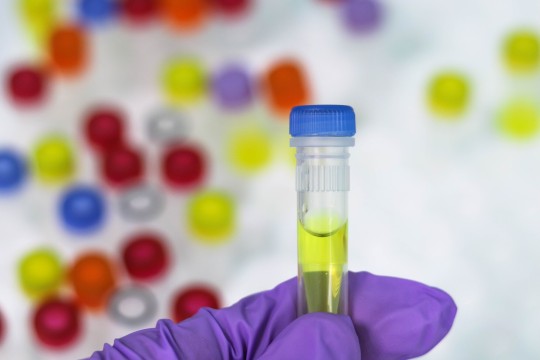Don't wanna be here? Send us removal request.
Text
About Chromatography Vials

Chromatography vials are commonly available in a wide range of materials. Their chromatography vial closures are important components, because they ensure that the sample is inert and safe from contamination. Three common types of closures are available: screw cap, crimp closure, and snap closure. All three have their advantages and disadvantages, and we will discuss each of them in more detail below. In addition, each type of closure is compatible with many different types of chromatography systems.
A filter vial is ideal for general specimens and can be either conical or flat. This type of vial allows the sample liquid to pass through the filter with a minimum amount of turbidity. Click http://chromtech.com/ for more details about this. Certain samples may require the use of borosilicate glass transport vials, while other samples are better suited to polypropylene containers. Regardless of your sample type and application, you should choose a suitable chromatography vial to ensure reliable results.
For applications requiring higher sensitivity, Performance Level 2 and 3 vials are available. These products feature a sealed lid and a PTFE/silicone septum. They are typically available in clear or amber glass, with a polypropylene screw cap. To ensure the safety of your samples, use only high-quality, non-toxic vials. In addition to the glass vials, you will need to purchase specialty use caps and mats for your samples.
The standard size of a chromatography vial is 12x32mm for 2mL samples and 15x45mm for 4mL samples. Other types of vials are available in a variety of shapes, sizes, and materials. Choose the mouth opening (normal, wide, or crimp) for your vials. The mouth opening also plays an important role in the type of cap you will use. For example, a standard glass vial with a 6 mm mouth opening will not fit in a robotic arm machine. Another type is the Limited Volume Vials. These vials can be plastic, glass, or a mixture of both materials. The latter type is also available with a glass insert, attached or removable. Browse this page to read more info about analytical vials for hplc now!
The choice of chromatography vials should be based on sample compatibility. In contrast to the standard N9, amber glass vials are suitable for sample storage if the solvent is not glass-stable. Similarly, silicone vials should be used for volatile samples. When using these vials, ensure that the septum is tightly sealed to prevent evaporation. There are several types of closures for chromatography vials, including screw cap and snap closure.
Plastic vials are the most common type of chromatography vials. They are lightweight, easy to handle, and relatively inexpensive. Compared to glass, they offer good chemical resistance and a durable construction. Some types are even available with a transparent amber hue. They are also durable and affordable. But there are a variety of advantages to plastic chromatography vials. So, choose the type according to your needs.
Chromatography vials can be pre-assembled with septa or sold separately. You may also purchase closures separately. Snap caps, on the other hand, can be used for short-term storage of chemical samples. The only drawback to Snap Caps is that they are difficult to remove. Nonetheless, they are highly recommended for volatile compounds. These chromatography vials are not only useful in research and development, but also in everyday life. Check out this post for more details: https://en.wikipedia.org/wiki/Vial.
0 notes
Text
Tips For Choosing Chromatography Vials

Chromatography vials come in various shapes and sizes. Type 1 borosilicate glass is the most common material used in chromatography. Polypropylene offers an affordable alternative to glass and is a good choice for pH-sensitive materials. Inserts can be flat, conical, or even flat-bottomed. Regardless of insert shape, all types of chromatography vials have the same capacity: 3.5 mL.
For organic samples, PTFE-faced 14B rubber lined screw caps are typically used. For glass chromatography vials, replacement caps are available separately. Click https://www.chromtech.com/ for more info. Regardless of their material composition, replacement caps are autoclavable. By the end of the analysis, a sample is completely protected and ready for further processing. And with these vials, chromatography can be performed as quickly as possible. A few tips for choosing a chromatography vial:
Increasing food safety concerns and increased demand for HPLC test are expected to drive the market for chromatography vials. Government regulations and stringent standards for lab consumables will also contribute to the growth of the market. However, other factors such as strict government plastic usage norms are expected to hinder the growth of the chromatography vials market. So, if you're planning to purchase chromatography vials in the near future, it is important to check with the manufacturer before placing an order.
The best type of closure for chromatography vials depends on the type of application you'll be performing. Crimp caps provide the most secure and reliable seal for gas chromatography, while screw caps are better for LC-MS and HPLC applications. To view more details about chromatography, see the website linked here now! However, personal preference is also a key factor when choosing chromatography vials. Snap caps offer a fast and easy seal but do not offer as good a sealing as crimp-top closures. Crimp caps are better for volatile substances.
Chromatography vials are a versatile way to collect samples. They come in several different sizes and shapes. Open-top vials are most commonly used. Their design is convenient for autosampler needle penetration. The septum-sealed caps prevent the needle from bending during the autosampler process. Additionally, their wide-mouthed caps are less likely to crimp or decapping.
When choosing chromatography vials, consider the compatibility of your samples and solvent. Light-sensitive solutions should be used in amber glass vials. In general, volatile samples need a closure that can minimize the risk of evaporation. Various types of closures are available, including screw cap, crimp, and snap. All of them work well for various applications. However, some of them are better suited for certain types of samples than others.
The original screw-thread vials were made of amber glass and clear borosilicate glass. This particular model comes with a graduated write-on patch. It is compatible with 8mm septa. It is also easier to use for laboratory-scale chromatography. A number of different sizes are available. You can find the right chromatography vial for your application. The choice is yours! Then, you can easily start using it! View more info relating to this topic here: https://en.wikipedia.org/wiki/Chromatography.
0 notes
Text
Chromatography Vials

Chromatography vials are used in the analysis of various samples. Their size varies from two to four milliliters (mL) and can have a wide mouth opening or a standard mouth opening. Vials may also be in plastic or glass and can have an insert made of glass or plastic that is attached or removable. Various types of cap are available to fit different types of samples. Some of these cap types are removable and are suitable for specific applications.
Glass and plastic vials have different specifications and are usually shaped like tubes or flat bottoms. Unlike blood collection tubes, vials are often made of different materials with different caps. These containers are used to store various laboratory samples and medicines. As such, they play a vital role in the workflow of many settings. Here are some of the most common types of chromatography vials. This article will discuss the features of each type.
Chromatography vials come in different styles and finishes. Some have crimp tops for permanent closures, while others feature snap or screw tops. Crimp top finishes are typically used for chromatography vials with aluminum crimp seals, which provide a tighter seal. Snap and screw tops allow for easier removal. Some vials come with a write-on patch, making it easier to identify the contents.
Chromatography vials are used in many different settings, from forensic labs to pharmaceutical laboratories. Regardless of the industry, these temporary containers are crucial for the analysis of various samples. Whether your lab needs liquid or gas chromatography, there's a vial that's perfect for you. If you are looking for high-quality chromatography vials, Tisch Scientific has a wide selection of chromatography vials available. All of its products have passed an ISO9001:2015 quality certification, so you can be assured of the highest level of accuracy.
Chromatography vials are available in glass, plastic, or amber. Glass vials protect their contents from ultraviolet light, which can cause damage to certain chemicals. Amber glass is the best choice for visibility, as it's easy to see what's inside. Glass amber vials are made of 33 expansion glass, which can be heated to over 500 degrees Celsius. Clear glass vials, on the other hand, are made of 51 expansion glass. Read this blog for more details.
The type of sample to be analyzed determines which septa are required. Vials with septa are suitable for a wide range of sample types. Depending on the type of sample to be analysed, there are 6 common types of liner. The hardness of rubber also affects how the seals will seal. But this is not a guarantee of performance. A better test is to ask the lab technician or laboratory manager for guidance. Get more enlightened about this article by reading this great post: https://www.dictionary.com/browse/vial.
1 note
·
View note